“and . . . they’re off. . . .” Joe Carbury to call his last race this year
 |
After a distinguished 45-year career as the voice of chuckwagon racing at the Calgary Stampede, Joe Carbury has decided to ride off into a well-deserved retirement. Carbury’s famous words – “And … they’re off!” – will echo for the final time this year on Sunday, July 13, when he calls the final heat of the 2008 GMC Rangeland Derby.
“Chuckwagon racing has been so much a part of my life, but I can see the finish line,” says Carbury, after calling thousands of races over more than four decades. “It’s with heavy heart that I’ll be calling my last race this year, but the time has come.”
When Carbury was inducted into the Alberta Sports of Fame and Museum in 2003, the veteran broadcaster of several sports admitted it was chuckwagon racing that gave him his fame and recognition throughout Alberta. He looks back with fondness at some of the true characters of chuckwagon racing, men like Tommy Dorchester, Orville Strandquist, Doyle “Doc” Mulaney and Ron Glass.
“Joe Carbury and his distinctive voice and presentation helped make chuckwagon racing what it is today,” says George Brookman, Calgary Stampede president and chairman of the board. “Because of his involvement with the GMC Rangeland Derby, Joe is recognized wherever he goes in Canada. We’re just thrilled to have him back for one more year.”
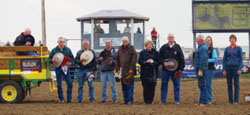 |
| Photo by Debbie Mason With hats removed in the High Chaparral Arena is Pat Perrin in the wagon and standing (left to right) Billy Drury, Jackie Lavallie, Shelton LaFramboise, Edwin Wayne Perrin, Eleanor (Jamieson) Suddaby, George Jamieson, Tom Reardon, Terri Mason and Mayor Anne Weisgerber. |
When the Cowboys Ruled Wembley
The weather-braving crowd at the opening of the Maple Creek Pro Rodeo honoured the memory of the six Maple Creek cowboys who made history when they were chosen to ride for King and Country at the First International Rodeo at Wembley Stadium in London, England at the 1924 British Empire Exhibition.
After seven-time CPRA Announcer of the Year Joe Braniff regaled the audience with the history and flavour of the historic rodeo, Joe tinged his famous voice with a British accent as pick-up men Gary and Wade Rempel, replete in angora chaps, took their place in the arena. Heritage bronc rider, 48-year-old Wade Weiss (Edwin Perrin’s grandson) burst out of the chutes with an impressive bronc ride.
After the arena was cleared, the tribute continued as descendants of Russell “Buck” Drury, Elmer Jamieson, Alex LaFramboise, Eddie Leveille, Donovan “Squint” Perrin and Edwin Perrin were transported into the arena by Ken Taplin’s fine team of matched roan Belgians (whip man was Eric Lawrence). Mayor Anne Weisgerber presented the descendants with Maple Creek souvenirs. Canadian Cowboy Country magazine editor Terri Mason presented each with a bound and personalized commemorative reprint of the original article, When the Cowboys Ruled Wembley, written by Royce Pettyjohn. The article first appeared in Canadian Cowboy Country magazine in October/November 2005.
At the conclusion of the presentations, everyone slipped back to 1924 for the singing of God Save the King.
Legends of Rodeo
 |
| Photo courtesy of CPRA Archives Albert Laye |
The Canadian Rodeo Historical Association is pleased to announce the recipients of the Ranchman’s Legends Achievement Awards. Chosen for their contribution to rodeo and the western lifestyle, the Legends have made a huge contribution to rodeo. Honoured this year are Albert Laye, Pete Bruised Head and the late Dale “Hoot” Rose.
Albert Laye competed in amateur rodeo from 1943?–?1945 and joined the Cowboys Protective Association in 1946. While he used to compete in all events, in his later years he chose tie-down roping, steer wrestling and cow milking. Albert accumulated more than 40 trophies throughout his rodeo career. Laye will be recognized June 21 at the Wainwright Stampede.
In the early days, Pete Bruised Head rode in all the roughstock events plus steer wrestling and tie-down roping. In 1967, Pete’s combined earnings between pro and Indian rodeos totalled more than World All Around champion Larry Mahan, topping out at over $52,000. When team roping came to Canadian rodeo, he entered the event at Cloverdale with his then 12-year-old son, Wright Bruised Head, and won.
At 72, Pete continues to enter the roping events in the Senior Pro and Indian Rodeos and continues to bring home the buckles. Bruised Head will be recognized at the Calgary Stampede.
The late Dale “Hoot” Rose competed in the unusual combination of bull riding and tie-down roping. Dale made his first rodeo appearance in 1955 at Medicine Hat and entered his first pro rodeo at Taber in 1961. His banner year was 1974 when he won the Guy Weadick Award at the Calgary Stampede and qualified for the inaugural Canadian Finals Rodeo in bull riding. He was always a crowd favourite, riding bulls wearing his signature white shirt and tie and puffing on a cigar.
At his arena west of Redcliff, Alta., Dale hosted bull-riding clinics whose alumni included 1983 World Champion bull rider, Cody Snyder.
(At press time, it is assumed Rose will be recognized at the Medicine Hat Stampede.)
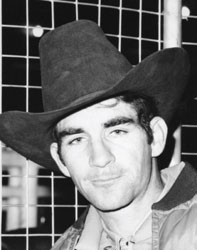 |
| Photo courtesy of CPRA Archives Dale “Hoot” Rose |
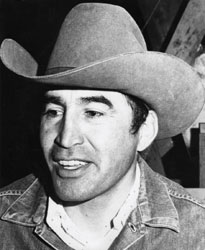 |
| Photo courtesy of CPRA Archives Pete Bruised Head |
Barrelling Down the Highway
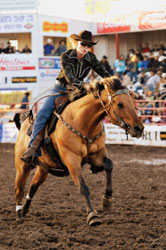 |
| Photo by Mike Copeman Miss Rodeo Canada 2008 Jenna Berreth barrelling home at Innisfail Pro Rodeo |
Miss Rodeo Canada 2008 Jenna Berreth’s schedule is jam-packed, a combination of days on the road and attending rodeos, pancake breakfasts, parades, schools, nursing homes, concerts and countless other community events – not to mention her own pro barrel racing schedule.
In mid-July, Jenna jetted off to Cheyenne Frontier Days in Wyoming. Her August schedule alone finds her in Dawson Creek, at her “hometown” rodeo at Jasper and down south in Lethbridge.
“Representing Canadian Rodeo and the western heritage is truly an honour,” enthused the effervescent Jenna.
Be sure to stop and have a visit with our First Lady of Canadian Rodeo at one of her many upcoming events and pick up an autographed photo.
T.R.A.S.H. for Kids
Team Roping at the Schmidt House is set to go August 11-13, 2008 at Ronald Schmidt’s ranch west of Barrhead. The lineup of roping coaches includes Joe Lucas, Daryn Knapp, Travis Gallais, Steele Depaoli, Dale and Wayne Skocdopole – plus rope horse trainers David and Leonard Schmidt, Travis Reay, Neil Branden and Murdock Keith – have all seen their fair share at the pay window. As well, Dr. Bob Steadward will focus on the mindset of a winning athlete.
The school is open to 30 young ropers (aged 10-16) and they must have roped before. Call 780-674-5288 to register your future Hall of Famer.
Grizzly Findings
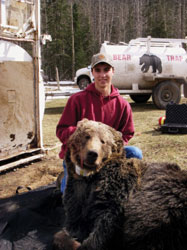 |
| Photo by Ron Wiebe The tranquilized grizzly was the object of great curiousity for Lane Thiessen and others, yet completely ignored by the horses in the nearby corral. In the background is the bear trap |
Bryn and Bonny Thiessen of Helmer Creek Ranch had a spooky couple of weeks at their place west of Sundre, Alta. Bonny, who has a small flock of sheep she uses to train her stock dogs, went out one morning to find one had been killed and, by all signs, it was by a grizzly.
A couple of days later, another sheep was killed and the “Fish and Feathers” department were called in to help.
Ron Wiebe, a Bear Response Team Leader with Alberta Fish and Wildlife, braved Bryn’s road and arrived with the bear trap. Bryn had “confirmed specifics of the bear’s travel” (tracked him) and, since the bear trail led within 100 yards of the house and then by the barn, that’s where Ron and Stan Hawes set up the bear trap.
They used one of the six killed sheep as bait to lure the bear.
“Bears get protective of the food sources they kill and will search for it,” said Wiebe.
It wasn’t long before the perfectly healthy, approximately six-year-old adult male grizzly was caught, tranquilized and collared with a radio device. (The collar eventually rots off.)
Asked if he ever had any trouble trapping bears, Wiebe replied, “Not if you’re good.”
As a Bear Response Team Leader – of which there are about 16 in Alberta Fish and Wildlife – Wiebe and others like him are called in to handle and work on grizzly bears, mauling incidents or ”high safety concern” situations.
“This is not an uncommon thing for bears that kill livestock,” Wiebe said, “We move them for their own safety and to keep them out of the ranchers’ sights.” The bear was transported to the Kakwa River area.
At one time our province used to be tiny pockets of civilization surrounded by a vast wilderness; today it’s tiny pockets of wilderness surrounded by a vast metropolis interlaced with countless roads. Not surprisingly, the bears, especially the grizzly, are literally being crowded out of the backcountry. As Sid Marty pointed out in his riveting new book, The Black Grizzly of Whiskey Creek: “Grizzly bears are coming to the ranchlands and making forays out onto the plains (their old homeland before we confined them to the mountains) to find peace and quiet.”
“It is becoming increasingly more difficult to move bears into anywhere in the province,” said Wiebe.
… and Them Wild Chilcotin Buckaroos, They Sure Know How to Ride…*
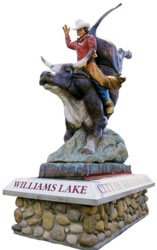 |
| Photo by Liz Twan B.C. cowboy legend Gerry Palmantier gets his statue |
The Cariboo city of Williams Lake, B.C., has unveiled the intricately carved statue honouring local cowboy and rancher, the late Gerry Palmantier.
Williams Lake Mayor Scott Nelson and a host of dignitaries joined the Palmantier family for the unveiling of the 15-foot-high statue honouring the late Chilcotin cowboy Gerry Palmantier.
Cariboo Regional District chair Jon Wolbers said the statue will serve as more than just a tribute to the man. “It honours the First Nations contribution to the great sport of rodeo.” Gerry was a proud blend of Chilcotin, Shuswap and American heritage.
Kristy Palmantier and her three children – Jody, Davee and Julie – unveiled the statue, created in the image of her late husband by Riske Creek artist Ken Sheen. “He matured from a cowboy to a cowman,” said Kristy, urging her children to follow their father’s example. “Be the best you can be.”
Former Xeni Gwet’in chief Roger William said he was honoured the City of Williams Lake chose to honour one of his Tsilhqot’in people. “Horses and cattle are a part of our transition. I’ve been rodeoing a long time and I looked up to Gerry Palmantier and the Palmantier family. I recognize him as one of our legends.”
Gerry’s grandfather, Leonard Palmantier was the co-founder of the famous Williams Lake Stampede. In 2006, the Palmantier family was inducted into the B.C. Cowboy Hall of Fame.
*from Hurtin’ Albertan, written by Corb Lund and Tim Hus.
Viva Charrería!
 |
| Photo courtesy of Royal Alberta Museum Arte en la Charrería: The Artisanship of Mexican Equestrian Culture was organized by International Arts & Artists, Washington, DC in collaboration with Luis González, Marisú González and Gabriel Cabello |
The Royal Alberta Museum in Edmonton is bringing in the famed Arte en la Charrería, the Artisanship of Mexican Equestrian Culture exhibit, October 25 – January 25, 2009.
This exhibit is a must-see, featuring the precise work of the charrería artisan; including spectacular sombreros, saddles, sidesaddles, bridles, quirts, stirrups, harnesses and intricate spurs with gold and silver embellishments.
The exhibit features contemporary and traditional charrería horse gear, the equivalent of working cowboy clothing and “show” clothing, as well as photographs and insightful interpretations of the rich history. Canadian Cowboy Country magazine is putting the final touches on our contribution to this event – stay tuned! Éste será magnifico!
Canadian High School Rodeo Finals Williams Lake, B.C.
 |
| Illustration by Michael Downs |
The famous Williams Lake Stampede committee is sweeping off their hats to welcome the hard-running, hard-riding rodeo competitors at the Canadian High School Rodeo Finals August 8-10.
Williams Lake is the first B.C. community to host this prestigious event.
The top five high school competitors aged 14-20 from British Columbia, Alberta, Saskatchewan, Manitoba and Ontario will be vying for the title of Canadian High School Champion in all the major roughstock and timed events. As well, there’s breakaway roping, pole bending, goat tying, team roping and cutting.
In all there will be about 180-200 of the best riders who qualified through regional and then individual provincial finals.
Starting off with a parade through Williams Lake, the city will be abuzz with competitors, parents, grandparents and some great rodeo stock. Come cheer them on; they are the future of rodeo!
For more information, visit williamslakestampede.com
Where in the World is Canadian Cowboy Country?
 |
| Photo by Mike Treloar Regular reader Sharon Low took us along to Tulúm, a Pre-Columbian Mayan walled city on the Yucatán Peninsula in the state of Quintana Roo, Mexico. |
The ruins, located on 39-ft (12-m) cliffs, allowed the Tulúm fort to serve as a defence against invasion. Tulúm appears to have been an important site for the worship of the Diving or Descending God.
While one inscription, since dated to 564 A.D., has been found at the site, most of the structures now visible were built between 1200 and 1450. The city remained occupied through the early years of the Spanish conquest of Yucatán, but was abandoned by the end of the 16th century.
Located 130 km (80 miles) south of Cancún, the archaeological attraction is one of the best-preserved coastal Mayan sites. The Tulúm ruins are the third most-visited archaeological site in Mexico, after Teotihuacan and Chichen Itza.















